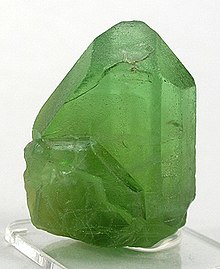
Back Olivien Afrikaans Olivín AN زبرجد زيتوني Arabic Olivin Azerbaijani Алівін Byelorussian Алівін BE-X-OLD Оливин Bulgarian Olivin BS Olivina Catalan Olivín Czech
| Olivine | |
|---|---|
 | |
| General | |
| Category | Nesosilicate Olivine group Olivine series |
| Formula (repeating unit) | (Mg,Fe)2SiO4 |
| IMA symbol | Ol[1] |
| Strunz classification | 9.AC.05 |
| Crystal system | Orthorhombic |
| Space group | Pbnm (no. 62) |
| Identification | |
| Color | Yellow to yellow-green |
| Crystal habit | Massive to granular |
| Cleavage | Poor |
| Fracture | Conchoidal |
| Tenacity | brittle |
| Mohs scale hardness | 6.5–7.0 |
| Luster | Vitreous |
| Streak | colorless or white |
| Diaphaneity | Transparent to translucent |
| Specific gravity | 3.2–4.5[2][3][4][5] |
| Optical properties | Biaxial (+) |
| Refractive index | nα = 1.630–1.650 nβ = 1.650–1.670 nγ = 1.670–1.690 |
| Birefringence | δ = 0.040 |
| References | [6][7][8] |
The mineral olivine (/ˈɒl.ɪˌviːn/) is a magnesium iron silicate with the chemical formula (Mg,Fe)2SiO4. It is a type of nesosilicate or orthosilicate. The primary component of the Earth's upper mantle,[9] it is a common mineral in Earth's subsurface, but weathers quickly on the surface. For this reason, olivine has been proposed as a good candidate for accelerated weathering to sequester carbon dioxide from the Earth's oceans and atmosphere, as part of climate change mitigation. Olivine also has many other historical uses, such as the gemstone peridot (or chrysolite), as well as industrial applications like metalworking processes.

The ratio of magnesium to iron varies between the two endmembers of the solid solution series: forsterite (Mg-endmember: Mg
2SiO
4) and fayalite (Fe-endmember: Fe
2SiO
4). Compositions of olivine are commonly expressed as molar percentages of forsterite (Fo) and/or fayalite (Fa) (e.g., Fo70Fa30, or just Fo70 with Fa30 implied). Forsterite's melting temperature is unusually high at atmospheric pressure, almost 1,900 °C (3,450 °F), while fayalite's is much lower – about 1,200 °C (2,190 °F). Melting temperature varies smoothly between the two endmembers, as do other properties. Olivine incorporates only minor amounts of elements other than oxygen (O), silicon (Si), magnesium (Mg) and iron (Fe). Manganese (Mn) and nickel (Ni) commonly are the additional elements present in highest concentrations.
Olivine gives its name to the group of minerals with a related structure (the olivine group) – which includes tephroite (Mn2SiO4), monticellite (CaMgSiO4), larnite (Ca2SiO4) and kirschsteinite (CaFeSiO4) (commonly also spelled kirschteinite[10]).
Olivine's crystal structure incorporates aspects of the orthorhombic P Bravais lattice, which arise from each silica (SiO4) unit being joined by metal divalent cations with each oxygen in SiO4 bound to three metal ions. It has a spinel-like structure similar to magnetite but uses one quadrivalent and two divalent cations M22+ M4+O4 instead of two trivalent and one divalent cations.[11]
- ^ Warr, L.N. (2021). "IMA–CNMNC approved mineral symbols". Mineralogical Magazine. 85 (3): 291–320. Bibcode:2021MinM...85..291W. doi:10.1180/mgm.2021.43. S2CID 235729616.
- ^ Mick R. Smith (1999). Stone: Building Stone, Rock Fill and Armourstone in Construction. Geological Society of London. pp. 62–. ISBN 978-1-86239-029-4.
Specific Gravity 3.5–4.5
- ^ Jessica Elzea Kogel (2006). Industrial Minerals & Rocks: Commodities, Markets, and Uses. SME. pp. 679–. ISBN 978-0-87335-233-8.
The specific gravity is approximately 3.2 when pure rises with increasing iron content.
- ^ "Olivine". Science.smith.edu. Archived from the original on 2014-01-20. Retrieved 2013-11-14.
G = 3.22 to 4.39. Specific gravity increases and hardness decreases with increasing Fe.
- ^ "University of Minnesota's Mineral Pages: Olivine". Geo.umn.edu. Archived from the original on 2013-10-17. Retrieved 2013-11-14.
Specific Gravity: 3.2 (Mg-rich variety) to 4.3 (Iron-rich variety) (average weight)
- ^ Olivine Archived 2014-12-09 at the Wayback Machine. Webmineral.com Retrieved on 2012-06-16.
- ^ Olivine Archived 2008-02-02 at the Wayback Machine. Mindat.org Retrieved on 2012-06-16.
- ^ Klein, Cornelis; C. S. Hurlburt (1985). Manual of Mineralogy (20th ed.). New York: John Wiley & Sons. ISBN 978-0-471-80580-9.
- ^ Garlick, Sarah (2014). Pocket Guide to the Rocks & Minerals of North America. National Geographic Society. p. 23. ISBN 9781426212826.
- ^ Klein & Hurlbut 1985, p. 373.
- ^ Ernst, W. G. Earth Materials. Englewood Cliffs, NJ: Prentice-Hall, 1969. p. 65
© MMXXIII Rich X Search. We shall prevail. All rights reserved. Rich X Search